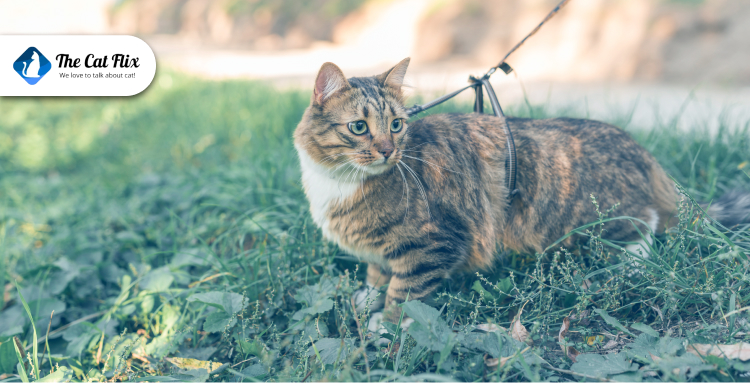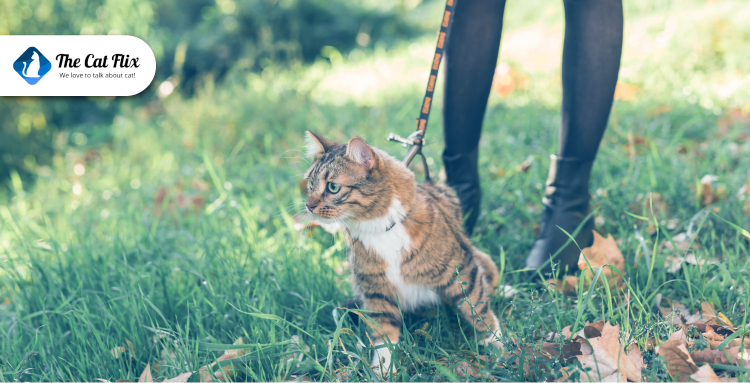Have you ever watched your cat curiously eyeing the world outside the window, tail twitching as birds flutter by? You might have thought, ‘What if they could explore out there safely?’ Well, good news—your cat doesn’t have to settle for indoor adventures forever. With a little patience and the right approach, you can teach your cat to walk on a leash and explore the outdoors like a true “adventure cat.”
Leash-walking is a great way to give them some extra exercise and mental stimulation, and it can even strengthen your bond. Now, we’re not talking about dragging your cat down the street – that’s a recipe for disaster. We will walk you through the steps of safely and patiently introducing your cat to a harness and leash, turning them into a confident little explorer.
What Things You Need Before Train Your Cat on Leash
But before you head out the door, you’ll need to gather a few essential items. Think of it as packing for a mini-adventure. Here’s what you need:
-
Well-fitted Harness or Halter
This is the most important piece of equipment. Forget about using a regular collar – it’s just not safe. Cats can easily slip out of them, and they can even injure themselves. You must use a harness or a fabric halter. These distribute the pressure more evenly across their body, making them much safer and more comfortable.
Harness or Halter? Both harnesses and fabric halters are good options. Harnesses typically have straps that go around the cat’s chest and shoulders, while halters fit more like a vest. Some cats prefer the feel of a halter, while others do better with a harness. You might need to experiment to see what your cat likes best.
No matter which style you choose, make sure it fits snugly but not too tightly. You should be able to slide two fingers under the straps. Measure your cat carefully and try on a few different harnesses or halters if you can. Look for a harness where the leash attaches to the back. This gives you better control.
-
Leash

You’ll need a lightweight leash. Some harnesses come with a matching leash, which is convenient. If not, don’t worry, you can easily buy one separately. A bungee-style leash (one with a little give) can be a great option, especially for beginners.
It has a little stretch, which makes it gentler on your cat if they pull or explore suddenly. Start with a short leash to stay close to your cat while they’re learning.
-
Tempting Rewards
Training is much easier with positive reinforcement. Find something your cat absolutely loves. This could be yummy treats. Small, soft ones work best. You want something they can eat quickly so you can keep the training session moving.
If your cat isn’t food-motivated, a favorite toy can work wonders. You can toss it a short distance to encourage them to walk forward. Also, you can try a wand toy or laser pointer. These can also be used to guide your cat’s movements but use them sparingly and responsibly. Don’t shine the laser pointer directly in their eyes.
Steps to Teach Your Cat to Walk on a Leash
Training your cat to walk on a leash takes patience, but it can be a rewarding experience too. Follow these simple steps to get started.
-
Introduce the Harness or Halter
This first step is all about making the harness or halter a positive experience for your cat. Start indoors, where they feel safe and comfortable. Let them sniff and investigate the new object. You can even use Feliway calming spray or sprinkle a little catnip on it to make it more enticing. Gently place the harness or halter on your cat for just a few seconds, then immediately reward them with a treat or a favorite toy.
Gradually increase the amount of time they wear it, always pairing it with positive reinforcement. This process might take several days or even weeks, so be patient and don’t rush it. The goal is for your cat to associate the harness or halter with good things.
-
Add the Leash
Once your cat is comfortable wearing the harness or halter, it’s time to introduce the leash. Clip it on and let your cat drag it around the house. This helps them get used to the weight and feel of it. Next, gently pick up the leash, but don’t pull or try to steer your cat. Instead, follow them as they walk. This teaches them that the leash isn’t something to be afraid of and that they still have some control. Continue practicing this inside until your cat moves freely and comfortably while you hold the loose leash.
-
Start Training Indoors (with Movement)

Now that your cat is used to the harness, halter, and leash, it’s time to start adding some direction. Put the harness or halter on your cat and give them a few treats. Then, take it off. Repeat this process several times, gradually increasing the time they wear it. Remember, only give treats when the harness or halter is on. This helps create a positive association.
Once they’re comfortable with this, attach the leash and follow them as they walk around. Keep the leash loose. After a few repetitions of this, gently try to guide them in a different direction using a treat as a lure. Reward them when they follow your lead and also when they walk on their own.
More for you: How to clicker train a cat to stay off counters
-
Go Outside but Start Slow
When you’re confident that your cat is ready for the great outdoors, choose a safe, quiet, and fully enclosed space to start. A fenced backyard or a quiet patio works well. Take your cat outside in their carrier with the harness or halter already on. Open the carrier and let them explore at their own pace. Some cats will eagerly jump out, while others will be more hesitant. Don’t force them. Once they’re out of the carrier, follow them gently as they explore.
On a nice day, you can try encouraging them to take their first steps outside the door by tossing a treat just a short distance away. If they seem frightened or hesitant, don’t push it. Try again another day. Keep these initial outdoor sessions short—just a few minutes—and always end on a positive note.
-
Understanding Cat Walking
It’s important to remember that walking a cat is very different from walking a dog. Cats are natural explorers and like to sniff, investigate, and stop frequently. Be prepared for a slower pace and lots of stops. Think of it as a leisurely stroll rather than a brisk walk. Let your cat lead the way and enjoy the experience together.
-
Repeat the Process
If the first outdoor experience goes well, repeat it regularly to reinforce the positive association. To make it even more predictable and enjoyable for your cat, create a routine. Use a specific phrase, like “It’s time for a walk,” and jiggle the leash as a signal.
This helps them understand what’s about to happen and can even build excitement. Consistency is key, and with patience and positive reinforcement, you and your cat can enjoy many happy outdoor adventures together.
Preparing Your Cat for Outdoor Adventures: Health and Comfort Tips

So, you’re excited to take your cat outside? Before that, you need 2 important things to take care of:
Make Sure Your Cat is Ready for Outside
Before venturing outside, schedule a visit to your veterinarian. Let them know about your outdoor plans, and they’ll guide you on the necessary precautions. Protect your cat with flea, tick, and heartworm prevention. Ensure their vaccinations are up to date, and don’t forget to deworm them to prevent any parasites they might pick up outdoors.
Next thing is spaying/neutering and microchipping. This is crucial for any cat who goes outside. Spaying/neutering reduces the risk of them wandering off or encountering other cats aggressively and prevents unwanted litter. Microchipping ensures your cat can be identified and returned to you if they get lost.
Increase Outdoor Fun
Every cat is different, and knowing your cat’s personality helps create enjoyable outdoor experiences. Is your cat active, curious, and eager to explore new places? Or do they prefer quiet corners and tend to shy away from changes?
For adventurous cats, outdoor activities can be a great way to channel their energy. But for timid cats, it’s best to start small. A catio is a wonderful way to let them experience the sights and sounds of nature while staying safe. Nevertheless, the outer world can be overwhelming for a cat at first. New sounds, smells, and sights—along with people and animals—can make them nervous. Take it slow. Start with short outings in a quiet, enclosed area where they feel safe.
Pay close attention to your cat’s reactions. If they seem scared or stressed, it’s okay to take a step back and try again another day. The goal is to make outdoor adventures fun and stress-free, not overwhelming. If you have a yard, you can make it even more appealing for your cat. Check out How to Create a Cat-Friendly Garden or Outdoor Space. This guide offers ideas to make outdoor time safe and enjoyable.
What You Need to Avoid While Leash Train Your Cat
- Wrong Harness: Use the right harness for the occasion: light for every day, escape-proof for travel, weather-protective for cold.
- Skipping Proper Indoor Training: Master indoor harness and leash walking before going outside.
- Chasing for Harness: Don’t chase your cat; wait for a calm moment. Respect their “no.”
- Door Dashing: Prevent your cat from running out the door unsupervised. Teach sit/stay at doorways.
- Cat Leading: Don’t let your cat lead; you should control the direction.
- Short Leash: Use a leash at least 10 feet long for more freedom.
- Over-Repeating Commands: Don’t repeat commands endlessly; it makes them meaningless.
- Regular Treats Outdoors: Use high-value treats (like small pieces of cooked chicken or fish) to compete with outdoor distractions.
- Tense Leash: Avoid pulling; give slack if your cat pulls back. Use short pressure bursts only for emergencies.
- No Post-Walk Reward: Allow free exploration and offer a meal after walks.
FAQs
When is the best time to leash train a cat?
The earlier you start, the better. Younger cats typically adapt more easily to leash training. However, with patience and effort, cats of any age, even older ones, can learn to enjoy walking on a leash.
Is it hard to train a cat to walk on a leash?
Leash training a cat isn’t hard but does require patience. On average, it may take about 2-3 weeks to get your cat comfortable enough for what resembles a “walk” similar to that of a dog.
Is leash walking good for cats?
Absolutely. Walking on a leash lets your cat explore the outdoors safely, providing physical exercise to reduce obesity risks and mental stimulation to keep them entertained. It’s also a wonderful way to bond with your cat.
Final Thoughts
Leash training your cat opens up a whole new world of exploration and enrichment for both of you. It’s a journey that requires patience, consistency, and a deep understanding of your cat’s needs. By following the steps outlined in this guide, you can safely introduce your cat to the joys of the outdoors. Also, you can strengthen your bond and provide them with valuable physical and mental stimulation. Remember to prioritize their comfort and safety above all else. With a little effort, you can transform your indoor kitty into a confident and happy adventure cat.
Found this guide helpful? Share it with other cat lovers and let us know about your leash-training experiences in the comments below.

